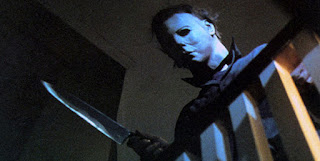Given how much the idea of watching
Audition freaked me out (mainly because of the scene where the
man eats vomit), it’s odd how I always somehow go into Carrie
without any real anxiety about seeing it again, and then get a sock
in the gut. I never seem to remember just how utterly disturbing
this movie is, in ways that have nothing to do with the supernatural
elements. There isn’t anything inherently evil about Carrie’s
power. Instead, this movie is about the human evil that would drive
a tormented young girl to commit mass murder.
In the unlikely event that this review
will be read by anyone who hasn’t seen the film, the plot is that a
girl grows up to be socially awkward and unpopular because of her
crazy, religious mother (Piper Laurie). Because of her mother’s
puritanical beliefs, Carrie (Sissy Spacek) doesn’t know about
menstruation. So when she has her first period, she freaks out in
the locker room and is pelted with tampons, humiliating her.
Eventually, this spirals into a chain of events, leading to the
ballot box being stuffed to make her Prom Queen, so that the leader
of the girls (Nancy Allen) can dump pig’s blood on her in a
misguided attempt at revenge. In retaliation for this, Carrie
slaughters her entire school using newly-awakened psychic powers.
Her psychic powers seem to wake up in
response to her puberty. A girl who has been repressed for years is
suddenly hitting the point in her life when her emotions an anxiety
become the strongest, and they're breaking free. As her powers
gradually awaken, no one but her mother is aware of them, her mother
calling Carrie a “witch.”
The events of this film are inevitable.
Nothing is shocking or surprising. Human beings attack a target
they perceive as weaker than themselves, and eventually, the target
responds violently. Everyone dies, Carrie included. And once the
events have been set in motion, I don’t think there’s one viewer
who doubts for even a single moment that it’s going to happen.
Most horror films work with shock. This film makes the horror
omnipresent throughout its entire run time.
TVTropes uses the term “Hope Spot”
to describe a point in a story in which it appears that things are
going to be OK, before they get worse. Carrie subverts this tendency
by having scenes which appear to be Hope Spots, but framed in a
position in the story to make it clear that no, things are still
going to suck. Most notable is Sue, one of the girls from the
initial assault, asking her boyfriend to take Carrie to the prom.
Between the instability of Carrie’s mother, Carrie’s psychic
powers and Chris (the aforementioned leader of the girls) plotting
against Carrie, we know instinctively that such an offer can serve
only to set the battleground for the eventual confrontation. It’s
obvious that the state of affairs cannot hold.
While I haven’t read the book, I have
seen the remake and find this to be easily the superior version. The
characters are far less black and white. In this version, rather
than evil, the antagonists are made out to simply be stupid
teenagers. They have yet to develop the level of empathy that would
have prevented the situation from occurring at all. Likewise, Carrie
has yet to develop an understanding of her life beyond her teenage
years.
On the flip side of the coin is Tommy
Ross. Rather than the pure hero of the remake, Tommy is initially
fairly indifferent to Carrie. While he would certainly never raise a
finger to harm her, he mocks her on at least one occasion, and has to
be all but forced by Sue to take her out at all. He’s a completely
normal, nice, popular teenager.
Hollywood always struggles to make
revenge films because they simultaneously do and do not want the
revenge to seem satisfying. For example, the 2002 version of The
Count of Monte Cristo had two endings rejected by the studio as
too depressing, because they would have hammered home the fact that
Dantes’ quest for revenge had left him with nothing. The decision
to give Carrie two climaxes seems like a fairly successful compromise
In this regard. You get the big, special effects-laden climax at the
prom, and then the incredibly depressing scene in which Carrie
returns home, is greeted by her now-homicidal mother, who she kills.
And the house is then destroyed, killing her too. So we see the
exciting revenge, and then we see the aftermath, with Carrie as a
scared, traumatized girl.
I certainly don’t recommend this
movie to everyone. No matter how good it is, it’s one of the most
depressing things I’ve ever seen. I can barely handle it, so far
be it for me to tell other people what they can or can’t deal with.
That said though, it’s still a classic.










